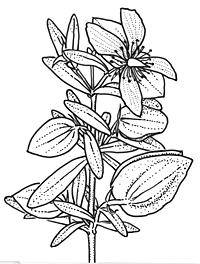Common name: St. Andrew’s Cross
Hypericum hypericoides (L.) Crantz APNI* Synonyms: Ascyrum hypericoides L. APNI*

Description: Shrub to 1.5 m high; stems terete (2-winged when young), reddish brown, erect to decumbent; bark exfoliating in shreds.
Leaves linear to narrowly oblong or oblanceolate, mostly 1–2 cm long, (0.2-) 0.3–0.7 cm wide, apex rounded to obtuse, narrowed into bases, margins somewhat recurved; glands dark-coloured; sessile or shortly petiolate.
Flowers terminal, often on short lateral shoots, 12–20 mm diam.; sepals 4, with outer pair 8–10 mm long and enlarging up to 12 mm in fruit, inner pair c. 4 mm long; petals c. 10 mm long, narrower than the larger sepals, yellow; stamens in a continuous band; styles 2.
Capsule c. 4–9 mm long, enclosed in enlarged outer sepals.
Distribution and occurrence: native N and C Amer. Recorded as naturalised from Crescent Head W to Kempsey. Disturbed and wet areas, including pasture, firebreak on flat ridgetop, and waterlogged soil in open depression in wetland.
NSW subdivisions: *NC
Distinguished by its 4-merous flowers. Specimens from N.S.W. have not been determined to subspecies. Sometimes placed in Clusiaceae.
Text by G.J. Harden & L.J. Murray, Supplement to Flora of NSW Vol. 1 (2000); updated by P.G. Kodela (June 2016)
Taxon concept: Australian Plant Census (accessed April 2017)
APNI* Provides a link to the Australian Plant Name Index (hosted by the Australian National Botanic Gardens) for comprehensive bibliographic data
***The AVH map option provides a detailed interactive Australia wide distribution map drawn from collections held by all major Australian herbaria participating in the Australian Virtual Herbarium project.
|


